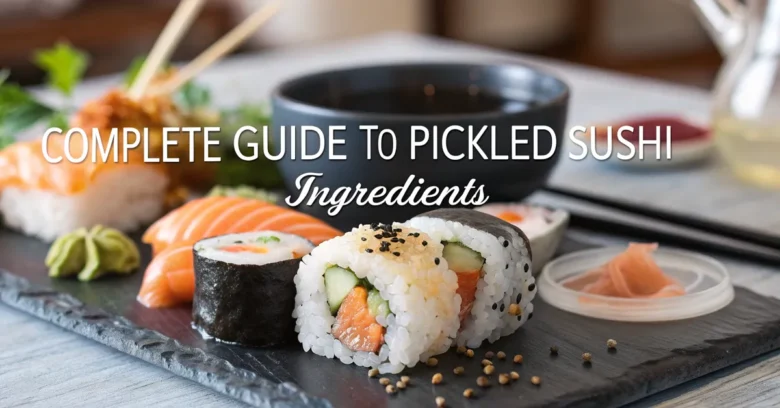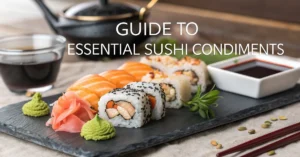Pickled sushi: a unique taste? Or a historical necessity?
Sushi, a beloved dish worldwide, has a history steeped in tradition and innovation. A cornerstone of authentic sushi lies in the art of preservation, and pickling emerges as a time-honored technique. Today, you can easily go to a Japanese restaurant to buy sushi, but it wasn’t always like that. The use of pickled ingredients in sushi has played a vital role in its evolution, flavor profile, and cultural significance.
Are you curious to explore the tangy and flavorful world of pickled sushi ingredients? This guide dives deep into the essential role that pickling plays in creating authentic sushi. Here, you’ll discover the history, techniques, and key ingredients that add that distinctive, unforgettable zest to this culinary art form.
A Brief History of Pickling in Sushi
Pickling wasn’t always a culinary choice. In ancient Japan, refrigeration wasn’t an option, and fish spoiled quickly. To combat this, people used salt and vinegar to preserve the fish. This allowed them to transport and store fish for longer periods. Pickling became an essential part of sushi preparation. The initial goal was preservation, but people quickly realized that pickling enhanced the taste and texture of sushi.
The Role of Pickling in Sushi
Today, refrigeration makes food preservation easier, but pickling remains a vital part of sushi. Pickled ingredients provide a unique blend of flavors and textures. Sweet, sour, and salty notes balance the richness of fish and rice. Pickling also adds a satisfying crunch to the sushi, making it more enjoyable. Pickling offers numerous benefits:
- Flavor Enhancement: Pickling infuses ingredients with tangy, sweet, and umami flavors that complement the other elements of sushi.
- Texture Contrast: Pickled items often provide a crisp, crunchy texture.
- Preservation: Although refrigeration has reduced its importance, pickling can still extend the shelf life of certain ingredients.
- Digestive Benefits: Some pickled items like ginger contain probiotics and enzymes that aid digestion.
Essential Pickled Ingredients in Sushi
Here are the must-know pickled ingredients when venturing into the world of sushi:
Gari (Pickled Ginger)
Gari is perhaps the most well-known pickled ingredient found alongside sushi. Thinly sliced ginger is pickled in a sweet vinegar solution. This results in a refreshing and palate-cleansing condiment.
- Flavor Profile: Gari offers a spicy, sweet, and slightly acidic flavor. Its sharpness helps to cut through the richness of the fish.
- Preparation: Young ginger roots are peeled, thinly sliced, and then briefly blanched. They are then pickled in a mixture of rice vinegar, sugar, and salt. Some recipes include sake for added depth of flavor.
- Uses in Sushi: Gari is typically eaten between different types of sushi. It clears the palate and allows you to savor the unique flavors of each piece.
Rakkyo (Pickled Scallions)
Rakkyo are small, white Japanese scallions that are pickled whole. Their mild onion flavor and crunchy texture make them a delightful addition to sushi meals.
- Flavor Profile: Rakkyo offers a mildly sweet, tangy, and slightly pungent flavor. They are less spicy than regular onions, making them palatable.
- Preparation: Rakkyo bulbs are cleaned, trimmed, and then pickled in a solution of rice vinegar, sugar, salt, and sometimes kombu (seaweed) for added umami.
- Uses in Sushi: Rakkyo are often served as a side dish alongside sushi. They are also chopped and added to sushi rolls for extra flavor and crunch.
Shibazuke (Pickled Cucumber and Eggplant)
Shibazuke is a type of pickle originating from Kyoto. It typically consists of cucumber, eggplant, and ginger pickled in red shiso leaves (perilla). The shiso leaves give the pickle a vibrant color and unique flavor.
- Flavor Profile: Shibazuke has a tangy, salty, and slightly herbal flavor. The shiso leaves contribute a distinctive aroma and taste.
- Preparation: Cucumber and eggplant are chopped and then pickled with ginger and shiso leaves in a salt and vinegar brine. The pickling process can take several days to allow the flavors to fully develop.
- Uses in Sushi: Shibazuke can be served as a side dish or used as a pickled ingredient in sushi rolls. Its vibrant color and flavor add visual appeal and complexity to sushi.
Beni Shoga (Red Pickled Ginger)
Beni shoga is another type of pickled ginger. It uses young ginger rhizomes pickled in umezu (plum vinegar). The umezu gives the ginger a bright red color and a tangy, salty flavor.
- Flavor Profile: Beni shoga is characterized by its strong, sour, and salty taste. Its intense flavor makes it a bold addition to sushi dishes.
- Preparation: Young ginger is pickled in umezu, which is a byproduct of umeboshi (Japanese pickled plums) production. The ginger absorbs the red color of the umezu during the pickling process.
- Uses in Sushi: Beni shoga is often served as a garnish or condiment with sushi and other Japanese dishes. Its strong flavor adds a zesty kick.
Umeboshi (Pickled Plums)
Umeboshi are Japanese pickled plums. They are known for their intensely sour, salty, and slightly sweet flavor. Umeboshi have been a staple in Japanese cuisine for centuries.
- Flavor Profile: Umeboshi are extremely sour and salty with a hint of sweetness. Their unique flavor is acquired and can be quite intense.
- Preparation: Ume plums are pickled in salt and then dried in the sun. They are often pickled with red shiso leaves for added flavor and color. The pickling process can take several months to complete.
- Uses in Sushi: Umeboshi are not typically used as a direct sushi ingredient. Instead, they are served as a side dish or used to make umeboshi paste. This paste can be added to sushi rolls for a tangy flavor.
Fukujinzuke (Pickled Vegetables)
Fukujinzuke is a type of pickled vegetable mixture that is often served with Japanese curry rice. The mixture typically includes daikon radish, eggplant, cucumber, lotus root, and ginger.
- Flavor Profile: Fukujinzuke offers a sweet, tangy, and slightly crunchy flavor. The variety of vegetables creates a complex and satisfying taste.
- Preparation: Vegetables are chopped and then pickled in a soy sauce-based brine with sugar, mirin (sweet rice wine), and other seasonings.
- Uses in Sushi: While not a traditional sushi ingredient, fukujinzuke can be a creative addition to sushi rolls. Its crunchy texture and varied flavors can add an interesting twist.
Beetroot
Beetroot is not part of the traditional sushi ingredients, but its inclusion in modern sushi-making has come about recently. It offers vibrant color and earthy flavor.
- Flavor Profile: Beetroot’s flavor is earthy and sweet. Its slightly bitter undertones add complexity.
- Preparation: Beetroot slices are pickled in vinegar, sugar, and spices to boost their natural sweetness.
- Uses in Sushi: Pickled beetroot can be sliced thinly and layered into sushi rolls. Its vivid color creates a visually appealing contrast against the white rice and other ingredients. It’s especially good with vegetarian sushi options.
Myoga Ginger
Myoga ginger is a Japanese ginger known for its mild flavor.
- Flavor Profile: Myoga has subtle ginger notes. Its mildness makes it great for adding a gentle zing to sushi without overpowering other flavors.
- Preparation: Myoga buds are pickled in rice vinegar and sugar. The solution preserves their delicate flavor.
- Uses in Sushi: Thinly sliced pickled myoga can be sprinkled over sushi rolls or used as a garnish. Its refreshing taste and aroma make it a great addition to summer sushi.
Making Pickled Ingredients at Home
Want to try your hand at making pickled ingredients for sushi at home? Here’s a general guide with tips to help you:
Basic Pickling Solution
The foundation of most pickled ingredients lies in a well-balanced pickling solution. Here’s a simple recipe to start with:
- 1 cup Rice Vinegar: Provides the necessary acidity.
- 1/2 cup Sugar: Balances the sourness and adds sweetness.
- 1 tablespoon Salt: Preserves the ingredients and enhances flavor.
- Optional: Kombu (dried kelp) or Dried Chili: To add depth and complexity.
General Pickling Steps
- Prepare the Vegetables: Wash and thinly slice the vegetables you want to pickle. Uniform slices ensure even pickling.
- Blanch (Optional): For some vegetables like ginger, blanching briefly in boiling water helps to soften them and remove excess bitterness.
- Combine Ingredients: Place the vegetables in a clean jar. Pour the pickling solution over them, ensuring they are fully submerged.
- Refrigerate: Seal the jar and refrigerate for at least 24 hours before using. The flavors will continue to develop over time.
Tips for Homemade Pickled Ingredients
- Use Fresh Ingredients: Choose high-quality, fresh vegetables for the best flavor and texture.
- Adjust Sweetness and Sourness: Taste the pickling solution and adjust the sugar and vinegar levels to suit your preference.
- Experiment with Flavors: Add other ingredients like citrus zest, herbs, or spices to create unique flavor profiles.
- Sterilize Jars: Ensure your jars are properly sterilized to prevent spoilage and extend the shelf life of your pickled ingredients.
Pickled Sushi Ingredient Combinations
How do pickled ingredients work together with other flavors? Here are some tried and tested combos:
Classic Combinations
- Salmon and Gari: The richness of salmon is beautifully balanced by the spiciness and acidity of pickled ginger.
- Tuna and Beni Shoga: The bold flavor of tuna is enhanced by the strong, sour notes of red pickled ginger.
- Cucumber and Shibazuke: The crisp freshness of cucumber is complemented by the tangy and slightly herbal flavor of shibazuke.
Modern Combinations
- Avocado and Pickled Beetroot: The creamy texture of avocado pairs well with the earthy sweetness of pickled beetroot. This combo adds a vegan twist to sushi.
- Tofu and Myoga Ginger: The mild flavor of tofu is elevated by the delicate ginger notes of pickled myoga. This is another vegetarian-friendly option.
- Crab and Rakkyo: The sweet and savory flavor of crab is balanced by the mild tanginess and crunch of pickled rakkyo.
How to Choose High-Quality Pickled Ingredients
When buying pre-made pickled ingredients, consider the following:
- Appearance: Look for vibrant colors and clear brines. Avoid products with dull colors or cloudy liquids.
- Texture: The ingredients should be firm and crisp, not mushy or slimy.
- Ingredients List: Check the label for artificial additives, preservatives, and excessive amounts of sugar or salt.
- Reputation: Buy from reputable brands or stores known for their quality products.
- Taste: If possible, sample the product before buying to ensure it meets your flavor preferences.
Storing Pickled Sushi Ingredients
Proper storage is essential to maintain the quality and safety of your pickled ingredients. Here are some guidelines:
- Refrigeration: Always store pickled ingredients in the refrigerator to slow down spoilage.
- Submerge: Ensure that the ingredients are fully submerged in their pickling solution to prevent mold growth.
- Airtight Containers: Use airtight containers to prevent the pickled ingredients from absorbing odors from other foods in the refrigerator.
- Shelf Life: Most commercially pickled ingredients have a shelf life of several months when stored properly. Homemade pickled ingredients may have a shorter shelf life, typically a few weeks.
- Discard if Spoiled: If you notice any signs of spoilage, such as mold, discoloration, or off odors, discard the product immediately.
Common Mistakes to Avoid When Pickling
Even though pickling is simple, there are some ways you could mess up your pickled ingredients. Here is how to make sure that you don’t do that:
Using the Wrong Type of Salt
Table salt often contains iodine and anti-caking agents that can discolor pickled vegetables and affect their flavor. Always use pickling salt, sea salt, or kosher salt, which are pure and do not contain these additives.
Insufficient Acidity
Acidity is crucial for preserving pickled vegetables and preventing the growth of harmful bacteria. Make sure your pickling solution has the correct ratio of vinegar to water and other ingredients.
Overcooking Vegetables
Overcooking vegetables before pickling can result in a mushy texture. Blanch vegetables only briefly to soften them slightly without making them too soft.
Not Sealing Jars Properly
Improperly sealed jars can lead to spoilage. Always use sterilized jars and follow proper canning procedures to ensure a tight seal.
Storing at Room Temperature
Storing pickled vegetables at room temperature can promote the growth of harmful bacteria. Always refrigerate pickled vegetables to maintain their safety and quality.
Pickled Ingredients and Modern Sushi Trends
While traditional pickled ingredients remain popular, modern sushi chefs are experimenting with new and innovative pickled items to add unique flavors and textures to their creations. Some trends include:
- Pickled Fruits: Pickling fruits like mango, pineapple, or grapes can add a sweet and tangy twist to sushi rolls.
- Pickled Vegetables: Pickling unusual vegetables like fennel, kohlrabi, or Brussels sprouts can introduce new flavors and textures.
- Fermented Pickles: Using fermentation techniques to pickle vegetables can add a complex, umami-rich flavor.
- Fusion Flavors: Incorporating pickled ingredients with flavors from other cuisines, such as kimchi or sauerkraut, can create exciting fusion sushi dishes.
Are Pickled Ingredients Healthy?
Pickled ingredients can offer several health benefits:
- Probiotics: Fermented pickled vegetables like kimchi and sauerkraut contain probiotics, which support gut health.
- Antioxidants: Many pickled vegetables are rich in antioxidants, which protect against cell damage.
- Nutrients: Some pickled ingredients retain essential vitamins and minerals from the original vegetables.
However, it’s essential to be aware of the potential drawbacks:
- High Sodium: Pickled ingredients often contain high levels of sodium.
- Added Sugar: Some pickled ingredients contain added sugar, which can contribute to weight gain.
- Acidity: The high acidity of pickled ingredients can erode tooth enamel if consumed in excess.
The Future of Pickled Ingredients in Sushi
Pickled ingredients have been vital to the history of sushi. As culinary trends evolve, pickled items will continue to play a key role. Chefs will likely find new ingredients, techniques, and flavor combinations to incorporate in their sushi. This will allow them to make sushi that are both traditional and innovative.
Should You Explore Pickled Sushi Ingredients?
Exploring the realm of pickled sushi ingredients invites you to experience how age-old preservation techniques can revolutionize your homemade sushi, enhancing its authenticity, taste, and texture. While modern refrigeration eases the pressure to preserve, the art of pickling continues to offer distinct flavors and textures that elevate sushi to new heights. So, dive in, experiment with the ingredients mentioned in this article, and create sushi that will bring you, your friends and family, back to the table for more.



